I do love digging through old pieces of linen that I’ve got here and there in boxes or drawers. I think this piece is particularly pretty, but it needs some serious clean up work. It’s a nice center piece for a table, or, on a small round table, could cover it completely.
I’ll be testing a new cleaner on this piece – I purchased a product called Restoration, which is supposed to restore vintage linens (or new ones, too, I guess) that are beset with stains, age discoloration, fold lines, etc. I can’t wait to give it a try! If you’ve every seen the website, Cynthia’s Linen Room, you’ll find she recommends it highly in her tips on laundering antique linens.
In any case, on this piece, you’ll see some nice, simple whitework and a very well done crocheted lace edge on a round linen accent piece.
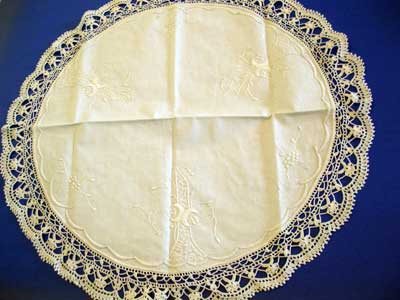
This is the whole piece. It is stained from age and has definite fold lines on it. The embroidery on it is not super fancy, but I think it’s ok. By far the prettiest part of the piece, in my mind, is the crocheted edge.
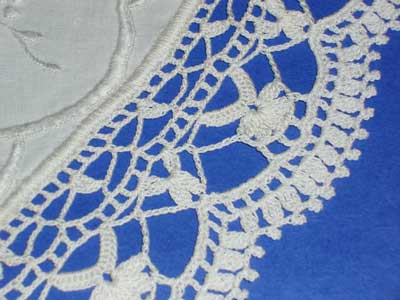
I like the pattern – the way it criss-crosses, and the little picots on the edge of the scallops.
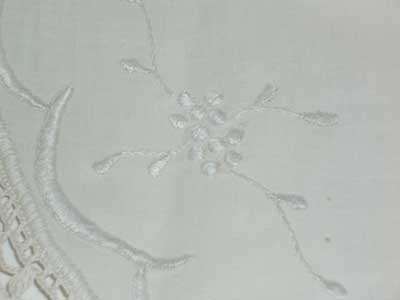
Here’s a close up on some of the embroidery. There’s a scallop design that circles the piece, and then two repeated motifs that alternate with each other around the piece.
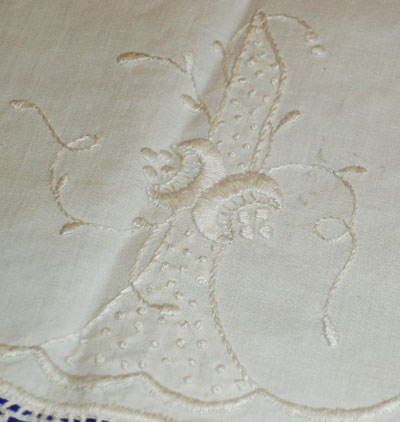
This motif cuts in three times around the piece, into the center. It’s kind of a strange pattern – a sort of little off-set scalloped cut into the center, with those two half-moon things and some vines. I love the use of the seeding in the background.
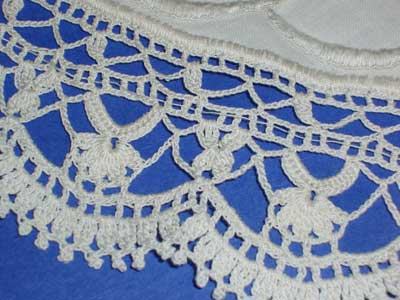
Here’s another close-up on the crochet. I have no idea what the little string is that runs through the crocheted squares. It runs about half-way around the whole piece. Any idea?
If you have any vintage linens or stained linens, how do you clean them? I’d be interested to hear. I’ll let you know how the Restoration stuff works – I have high hopes for it!







I look forward to your review of the cleaner. I posted some of my vintage inherited pieces a while back: http://lifeneedleworkandeverything.blogspot.com/2007/08/lace-questons.html
and many need a cleaning.
That thread is a bit of an enigma – very odd.
Margaret
Woo hoo! Thanks very much for this info’ and linkage! As I launched into embroidery earlier this year, I went on a bit of a vintage, stamped, to be embroidered, linen bender. I’m crazy for some of those old Vogart, Bucilla, etc., pieces that have been hanging around for decades, waiting for someone to bring them to life with some colorful stitching.
But once I had them all sitting in front of me I realized I didn’t really want to invest the time embroidering them if I was never really going to be able to use them because of the extremely noticeable fold line stains.
Do you know, I even wrote Martha Stewart to ask advice about how to remove fold lines from linen. She never answered. We’re not as close as I thought we were. lol! I can’t wait to see what you think of this product! – Jeannine
Margaret! I checked out your link – I love those pieces – all of them are gorgeous, but the third one down is my favorite! It’s stunning!
Jeannine! I think this stuff is supposed to work well… but I wonder what would happen if you washed a stamped piece before embroidering it?! I wonder if the lines would disappear? I was cracking up over your Martha Stewart line!
Thanks for your comments!
Mary
I think Restoration will work fine on an all-white piece, but be careful with colours. I tried it on a very dirty crewel piece and it really leached the colours out of the crewel wool. Fortunately, the piece was already in pretty bad shape. I am now a little leery of Restoration, but I would try it on whites.
It’d be really interesting if someone did a comparison of the various cleaning products for needlework….hint, hint. (I know, that’s a lot of work! 🙂
Actually, I’d like to do that, Margaret! I’d need to drum up a list, though, of the different commonly used products. I’ve heard a product called Orvus equine soap is supposed to be good for cleaning linens. It apparently isn’t properly a soap, but a wetting agent. Perhaps I should look into that. I just unboxed a slew of vintage linens – featuring some really beautiful and intricate drawn thread work – but they also need to be cleaned.
So much to do…. !!
Oh, Margaret, good to know that colors may run! Thanks!
I’m not 100% sure, Mary, but I thought that the pattern lines might very well disappear if I tried to wash the linens first. I think I’ll solve the problem by taking the pieces to my local copy shop (scanner for Christmas pleeease). I’d like to preserve the designs on paper regardless of how things go with cleaning up and embroidering the vintage linens.
If I have copies at the ready, I can go ahead and see how the clean up goes and if the patterns disappear in the process I’ll be able to hand draw them back on. – Jeannine
Hi Mary
Thanks for the link to Cynthias. I just finished reading her cleaning tips and there are some great helps in there. I prchased 4 very large antique hand towels with 6-8 of fringe. I washed 2 and spent hours with a metal hair pick combing thru the fringe. Her way sounds so much better. I do have them hanging in our guest bathroom against a pair of black terry towels and they are striking.
Thanks for all yor wonderful articles. I read every one.
I also agree with you re Trish burr. Love her books.
I have a giant container of ORVUS WA Paste from State Line Tack – sold for horse cleaning! It is a 4 ingredient cleaner – sodium lauryl sulfate, lauryl alcohol, sodium sulfate, and water. It was recommended by a couple of people in my EGA chapter and I purchased it to clean some old needlepoint chair seats. I didn’t notice any major dye loss – although with the amount of dirt in the pieces it would have been hard to tell. Some stains just didn’t come out, although the pieces looked much better after their washing, which is why I’m looking for something else for the old laces I have.
Catherine Jordan, one of the people who recommended it to me, sells small amounts on her web site and gives the description “pH neutral detergent; no phosphates/bio-degradable. Safe for fine linens.” She sells 3 oz. containers – I purchased a 120 oz. container since I had the 5 chair seats to do but even after them and some felting and a few other delicate things, I still have well over half of the container. It goes a long way.
Margaret H.
Beautiful edging on this piece! I love that kind of crochet.
I subscribe to Martha Stewart Living and in that magazine she has a question and answer segment. I think I recall recently that she talked about old linens and fold lines. I will have to look back and see what I can find. I’ll post whatever I come up with.
Sady said
I buy old linen doilies that have crochet on the edges. Most of the time the linen part is in bad shape not suitable for embroidery. I soak all in cold water and Biz. Sometimes they soak for 24 hours and then I really really really rinse them well. So for I have gotten every stain. These I paint flowers on and then frame behind glass. I think the needle work of another generation should be preserved and these types of linens are usually thrown away. I did do some beginning Hardanger on a one piece that I found.
Hi Mary,
I’m not sure what that little thread running halfway through the piece is for. I’m pretty sure it isn’t required for the stitching so my best guess is that it was inserted to assist with blocking the doily (to “ease” and extra fullness and make it lay quite flat).
Megan
Restoration is a staple and “go to” cleaner for my vintage and antique white-on-white linen acquisitions. It returns linens to bright white and removes most stains and storage residue. I generally soak the linens overnight in hot water and often do more than one soak. As for removing fold lines…I haven’t used it specifically for that purpose and can’t say that the product use is intended for that. Linens that have been folded the same way for years may release some of the fold creases through soaking, but many will retain creases to some extent. Restoration is SAFE for these linens…BIZ is not good for the fibers!
If you haven’t purchased from Cynthia’s Linen Room, give her a try. She is a lovely person. Em’s Heart Linens sells superior vintage and antique linens. Her vintage/antique linens arrive to your home cleaned and pristine!
I think the piece of string going through is to draw in the edges so that it fits over a milk or cream jug my granny had one just like it when I was a child many moons ago
This is a post on a REALLY old topic, but here’s my experience:
I inherited some old embroidered linens (colored or white cotton floss) with cotton crocheted lace edging which were very yellowed, plus had some stains. These had been laundered over the years of use, so washing and age had probably already taken out some of the dye. I had read about using borax to whiten and stiffen crochet and tatting (it’s not supposed to yellow like standard starch), but the source (an old Australian pattern book) didn’t give any directions or recipe. I got some Borateem borax and mixed it up 1/2 strength of what the box said for stain removal, in cold water and let the pieces soak (separately) for 24 hours before rinsing and air-drying. I ironed to remove wrinkles before they were completely dry and also then blocked the crocheted edges. They turned out great except some minor stains didn’t clear up completely…probably set from previous launderings. The colored embroidery actually appeared brighter and I didn’t find any color bleeding when I tested with a white paper towel. This was over 10 years ago and those pieces still look great.
I have since used borax soaking to clean linen and cotton pieces of white embroidery as well as crochet work that I have just completed and it works very well. DMC brand cotton crochet thread has been colorfast so far with this method. I haven’t used it on modern colored embroidery threads, so I can’t vouch for it there. I’d suggest testing the thread with this method before you use it if you plan to clean with borax after finishing the work.
I have tried Orvus before and wasn’t that impressed. It cleaned, but I had some color bleeding and it also seemed difficult to rinse completely.
A total disaster was the time I used OxiClean to soak out a piece of colored embroidery (fortunately, not large or valuable). This WILL cause colors to bleed (which has happened in regular laundry also).
Restoration works extremely well. I cleaned my granddaughter’s christening outfit for 15 minutes and it was done. Did’t have to soak it again. Just had to rinse it.
Next on my list are a few wedding gowns. Lace and all